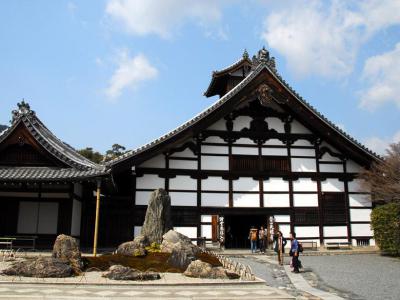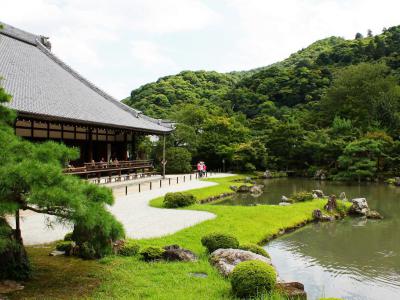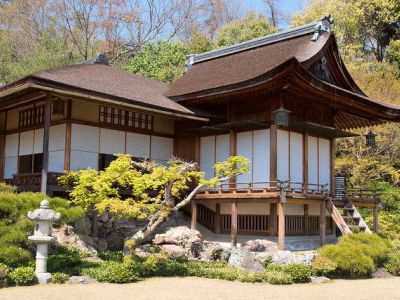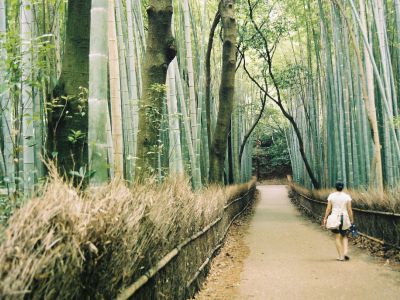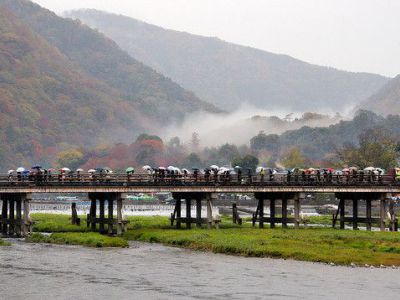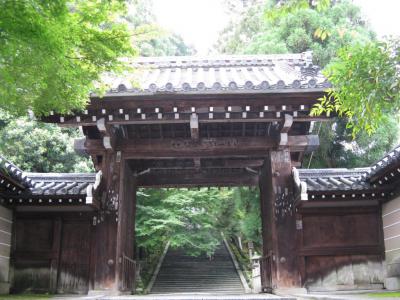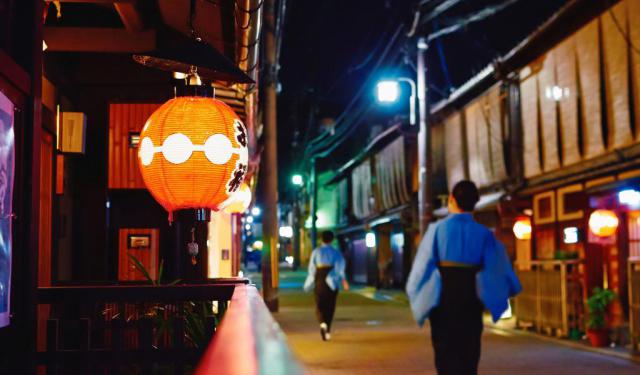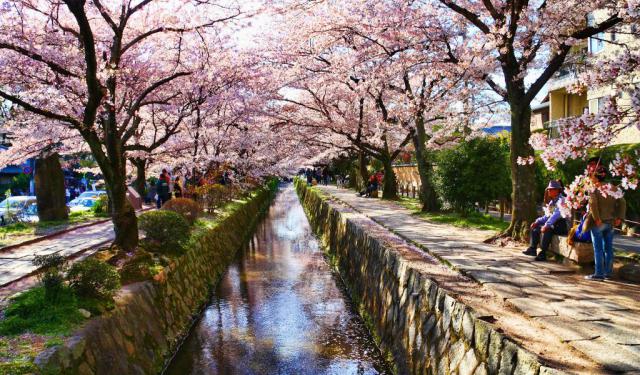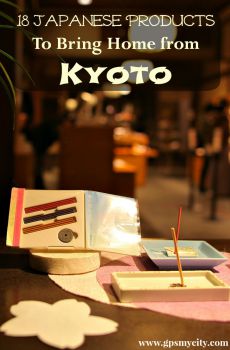
Arashiyama and Bamboo Grove Walking Tour (Self Guided), Kyoto
The Arashiyama district of Kyoto is slightly out of the way for tourists, but that means you can enjoy it more comfortably.
Undoubtedly, the most popular attraction here is the iconic Bamboo Grove, a mesmerizing forest of towering bamboo stalks that sway gently in the breeze, creating an ethereal atmosphere. This serene setting is a must-visit for travelers seeking tranquility amidst nature's splendor.
Adjacent to the Bamboo Grove is the Tenryu-ji Temple, a UNESCO World Heritage Site revered for its historical importance and stunning architecture. Within the temple grounds lies the Sogenchi Garden, a meticulously landscaped Zen garden that epitomizes the harmony between man and nature. Visitors can wander through its pathways, admiring the carefully arranged rocks, moss, and foliage that create a sense of calm and contemplation.
Nearby, the Okochi Sanso Villa offers another glimpse into the region's cultural heritage. Once the private retreat of a famous Japanese actor, this sprawling estate boasts traditional gardens, teahouses, and panoramic views of the surrounding landscape.
The Togetsukyo Bridge spans the Katsura River, providing a picturesque vantage point for admiring the scenic beauty of Arashiyama. From here, visitors can embark on leisurely strolls along the riverbanks or enjoy boat rides offering unique perspectives of the area.
Horin-ji Temple, with its ancient pagoda and tranquil ambiance, offers further opportunities for exploration and reflection. Meanwhile, adventurous travelers can venture to the Iwatayama Monkey Park, where they can observe Japanese macaques in their natural habitat.
The Arashiyama scenery is unparalleled and therapeutic, especially if you visit Kyoto during sakura season or when the autumn leaves change color. There is also a welcoming rustic town with lots of shops and restaurants, or you can check out a few ryokans (traditional Japanese inns) if your budget can support it. So why wait? Embark on a self-guided journey to Arashiyama today and enjoy the timeless allure of this remarkable destination.
Undoubtedly, the most popular attraction here is the iconic Bamboo Grove, a mesmerizing forest of towering bamboo stalks that sway gently in the breeze, creating an ethereal atmosphere. This serene setting is a must-visit for travelers seeking tranquility amidst nature's splendor.
Adjacent to the Bamboo Grove is the Tenryu-ji Temple, a UNESCO World Heritage Site revered for its historical importance and stunning architecture. Within the temple grounds lies the Sogenchi Garden, a meticulously landscaped Zen garden that epitomizes the harmony between man and nature. Visitors can wander through its pathways, admiring the carefully arranged rocks, moss, and foliage that create a sense of calm and contemplation.
Nearby, the Okochi Sanso Villa offers another glimpse into the region's cultural heritage. Once the private retreat of a famous Japanese actor, this sprawling estate boasts traditional gardens, teahouses, and panoramic views of the surrounding landscape.
The Togetsukyo Bridge spans the Katsura River, providing a picturesque vantage point for admiring the scenic beauty of Arashiyama. From here, visitors can embark on leisurely strolls along the riverbanks or enjoy boat rides offering unique perspectives of the area.
Horin-ji Temple, with its ancient pagoda and tranquil ambiance, offers further opportunities for exploration and reflection. Meanwhile, adventurous travelers can venture to the Iwatayama Monkey Park, where they can observe Japanese macaques in their natural habitat.
The Arashiyama scenery is unparalleled and therapeutic, especially if you visit Kyoto during sakura season or when the autumn leaves change color. There is also a welcoming rustic town with lots of shops and restaurants, or you can check out a few ryokans (traditional Japanese inns) if your budget can support it. So why wait? Embark on a self-guided journey to Arashiyama today and enjoy the timeless allure of this remarkable destination.
How it works: Download the app "GPSmyCity: Walks in 1K+ Cities" from Apple App Store or Google Play Store to your mobile phone or tablet. The app turns your mobile device into a personal tour guide and its built-in GPS navigation functions guide you from one tour stop to next. The app works offline, so no data plan is needed when traveling abroad.
Arashiyama and Bamboo Grove Walking Tour Map
Guide Name: Arashiyama and Bamboo Grove Walking Tour
Guide Location: Japan » Kyoto (See other walking tours in Kyoto)
Guide Type: Self-guided Walking Tour (Sightseeing)
# of Attractions: 7
Tour Duration: 2 Hour(s)
Travel Distance: 3.4 Km or 2.1 Miles
Author: emma
Sight(s) Featured in This Guide:
Guide Location: Japan » Kyoto (See other walking tours in Kyoto)
Guide Type: Self-guided Walking Tour (Sightseeing)
# of Attractions: 7
Tour Duration: 2 Hour(s)
Travel Distance: 3.4 Km or 2.1 Miles
Author: emma
Sight(s) Featured in This Guide:
- Tenryu-ji Temple
- Tenryu-ji Temple – Sogenchi Garden
- Okochi Sanso Villa
- Arashiyama Bamboo Grove
- Togetsukyo Bridge
- Horin-ji Temple
- Iwatayama Monkey Park
1) Tenryu-ji Temple
Expansive, adorned with cherry blossoms and maple trees, and honored as a UNESCO World Heritage site, Tenryu-ji is a haven nestled in the midst of popular Arashiyama. Despite drawing a steady stream of visitors, its generous proportions easily accommodate the crowds.
Established in 1339 by Shogun Ashikaga Takauji (1305-1358) in attempt to appease the spirit of Emperor Go-Daigo, whom he had once betrayed in his pursuit of power, Tenryu-ji originally comprised 150 buildings, many of which succumbed to fires over the centuries. The structures standing today date back to the Meiji period, yet the garden remains a testament to its original design by the revered garden master Muso Soseki, the temple's first head priest.
Along the approach to the temple, subtemples line the pathway, their open gates revealing immaculate front gardens. At the center lies the Lotus Pond, captivating visitors when the lotus flowers bloom in July, symbolizing enlightenment. The Lecture Hall, reconstructed in 1900, features a ceiling painted with a dragon amidst swirling clouds, alongside a statue of Shakyamuni, the historical Buddha. Additionally, Tenryu-ji offers a refined dining experience with its high-end Zen restaurant.
Established in 1339 by Shogun Ashikaga Takauji (1305-1358) in attempt to appease the spirit of Emperor Go-Daigo, whom he had once betrayed in his pursuit of power, Tenryu-ji originally comprised 150 buildings, many of which succumbed to fires over the centuries. The structures standing today date back to the Meiji period, yet the garden remains a testament to its original design by the revered garden master Muso Soseki, the temple's first head priest.
Along the approach to the temple, subtemples line the pathway, their open gates revealing immaculate front gardens. At the center lies the Lotus Pond, captivating visitors when the lotus flowers bloom in July, symbolizing enlightenment. The Lecture Hall, reconstructed in 1900, features a ceiling painted with a dragon amidst swirling clouds, alongside a statue of Shakyamuni, the historical Buddha. Additionally, Tenryu-ji offers a refined dining experience with its high-end Zen restaurant.
2) Tenryu-ji Temple – Sogenchi Garden
Considered one of Kyoto's very best sights, the garden enveloping Tenryu-ji Temple seamlessly blends elements of nature to create a harmonious landscape. White sand, arranged in wave patterns, intermingles with moss, flowers and trees, punctuated by an impressive collection of rocks set upon a tranquil pond. Sole survivor from the temple's original design, the pond itself forms the shape of the Chinese character "kokoro", meaning "enlightened heart". Intended to be admired from the veranda of the Abbot's Quarters, it presents a three-dimensional tableau, featuring a waterfall, peninsula, and rocky shoreline mimicking a seascape, all framed by the distant hills.
A leisurely stroll along the path on the pond's far side guides visitors past shrubbery carefully positioned to obscure direct views of the pond and heighten focus on the surrounding flora. For Muso Soseki, the garden's designer and first temple abbot, it served as a conduit to realizing one's inner Buddha nature, emphasizing contemplation as a path to enlightenment.
Take your time to wander the garden, soaking in its breathtaking vistas and capturing memorable photos. Despite its compact size, exploring alongside the temple (which requires a combined ticket) can be completed in under an hour, even at a leisurely pace. And even if you opt not to enter the temple buildings, glimpses into some of them can be enjoyed while circling the pond.
A leisurely stroll along the path on the pond's far side guides visitors past shrubbery carefully positioned to obscure direct views of the pond and heighten focus on the surrounding flora. For Muso Soseki, the garden's designer and first temple abbot, it served as a conduit to realizing one's inner Buddha nature, emphasizing contemplation as a path to enlightenment.
Take your time to wander the garden, soaking in its breathtaking vistas and capturing memorable photos. Despite its compact size, exploring alongside the temple (which requires a combined ticket) can be completed in under an hour, even at a leisurely pace. And even if you opt not to enter the temple buildings, glimpses into some of them can be enjoyed while circling the pond.
3) Okochi Sanso Villa
Kyoto was once hailed as the "Hollywood of Japan", with bustling studios and renowned film stars flocking to the Uzumasa district. During its zenith in the 1930s, an impressive 500 films were churned out annually in the district. Among the top stars was Okochi Denjiro (1898–1962), acclaimed for his portrayal of a samurai marked by a scarred eye and a missing arm. His fame brought fortune, but also spurred him to create a retreat where he could invest not just money, but his very essence.
A devout Buddhist, Okochi envisioned his villa as a homage to nature's teachings. Strategically nestled atop a hill ridge, it offered panoramic vistas of the Hozugawa Gorge and the revered Mount Hiei. Here, he erected a residence infused with traditional aesthetics, eschewing extravagant film decor for understated elegance and organic charm.
At the heart of the estate lies the inner garden, accessible through a "middle gate". A meandering path guides visitors through a succession of enchanting sights, from quaint tea houses to the picturesque viewpoint, culminating in a serene Buddhist shrine. Meticulously manicured shrubbery and "borrowed scenery" epitomize the finest of Japanese landscaping traditions.
For three decades, Okochi perfected every facet of his estate, carefully curating the seasonal blooms and foliage to reflect nature's cyclical beauty. Following his demise, the grounds were opened to the public, accompanied by an open-air museum commemorating his illustrious career. While the entrance fee may deter some, it ensures a tranquil ambience conducive to savoring complimentary matcha tea amidst the serene allure of a film star's abode infused with Zen sensibilities.
A devout Buddhist, Okochi envisioned his villa as a homage to nature's teachings. Strategically nestled atop a hill ridge, it offered panoramic vistas of the Hozugawa Gorge and the revered Mount Hiei. Here, he erected a residence infused with traditional aesthetics, eschewing extravagant film decor for understated elegance and organic charm.
At the heart of the estate lies the inner garden, accessible through a "middle gate". A meandering path guides visitors through a succession of enchanting sights, from quaint tea houses to the picturesque viewpoint, culminating in a serene Buddhist shrine. Meticulously manicured shrubbery and "borrowed scenery" epitomize the finest of Japanese landscaping traditions.
For three decades, Okochi perfected every facet of his estate, carefully curating the seasonal blooms and foliage to reflect nature's cyclical beauty. Following his demise, the grounds were opened to the public, accompanied by an open-air museum commemorating his illustrious career. While the entrance fee may deter some, it ensures a tranquil ambience conducive to savoring complimentary matcha tea amidst the serene allure of a film star's abode infused with Zen sensibilities.
4) Arashiyama Bamboo Grove (must see)
Arashiyama's bamboo grove is a magnet for photographers, enchanting visitors with its towering stalks swaying gracefully like nature's own dancers. While bamboo is renowned for its resilience and flexibility, here its aesthetic allure takes center stage.
Conveniently situated next to the Tenryu-ji Temple and connected to hidden shrines, this atmospheric forested area costs nothing to enjoy, and if you head out early in the morning on weekdays you will (almost) have it to yourself. With luck on your side and tourist crowds at bay, you'll hear the clink of the canes leaning into each other and – on a bright day – find radiant beams of sunlight filtering through the dense foliage, casting ethereal patterns on the forest floor.
A stroll through this verdant wonderland is a brief yet immersive experience, allowing you to traverse one of the "10 most beautiful tree tunnels in the world" before venturing forth to explore the myriad other treasures that Arashiyama has to offer.
Conveniently situated next to the Tenryu-ji Temple and connected to hidden shrines, this atmospheric forested area costs nothing to enjoy, and if you head out early in the morning on weekdays you will (almost) have it to yourself. With luck on your side and tourist crowds at bay, you'll hear the clink of the canes leaning into each other and – on a bright day – find radiant beams of sunlight filtering through the dense foliage, casting ethereal patterns on the forest floor.
A stroll through this verdant wonderland is a brief yet immersive experience, allowing you to traverse one of the "10 most beautiful tree tunnels in the world" before venturing forth to explore the myriad other treasures that Arashiyama has to offer.
5) Togetsukyo Bridge
At the heart of the Arashiyama district, Togetsukyo, or the "Moon Crossing Bridge", spans across the Katsura River, framed by the majestic Mount Arashi. Originally built in the Heian Period (794-1185) and last restored in the 1930s, this famous landmark exudes a timeless allure, especially during the vibrant hues of autumn foliage and the ethereal beauty of cherry blossoms in spring.
Despite its traditional appearance, the Togetsukyo blends ancient charm with modern engineering, its reinforced concrete columns and beams complemented by cypress parapets. Legend has it that the bridge earned its poetic moniker when Emperor Kameyama beheld a shimmering moonrise over the river, resembling the moon itself traversing the bridge. Since then, it has stood witness to feudal conflicts, samurai clashes, and inspired countless haiku poems.
Visitors are invited to capture Togetsukyo 's beauty from various angles, buy souvenirs from the shops at each end, embark on a rickshaw ride along the riverbanks, or indulge in delectable treats from nearby food stalls and eateries. During the summer months, the bridge comes alive with the age-old tradition of cormorant fishing, offering a captivating glimpse into Japanese culture.
Despite its traditional appearance, the Togetsukyo blends ancient charm with modern engineering, its reinforced concrete columns and beams complemented by cypress parapets. Legend has it that the bridge earned its poetic moniker when Emperor Kameyama beheld a shimmering moonrise over the river, resembling the moon itself traversing the bridge. Since then, it has stood witness to feudal conflicts, samurai clashes, and inspired countless haiku poems.
Visitors are invited to capture Togetsukyo 's beauty from various angles, buy souvenirs from the shops at each end, embark on a rickshaw ride along the riverbanks, or indulge in delectable treats from nearby food stalls and eateries. During the summer months, the bridge comes alive with the age-old tradition of cormorant fishing, offering a captivating glimpse into Japanese culture.
6) Horin-ji Temple
Perched atop a hill overlooking Arashiyama's famous Togetsukyo bridge, Hōrin-ji Temple beckons with its serene ambiance and rich cultural significance. Within its precincts resides Kokūzō Bosatsu, revered as one of Japan's foremost Bodhisattvas, believed to bestow wisdom and expedite mastery in various pursuits.
Among the temple's intriguing traditions is the "Hari-Kuyō" ceremony held on December 8th, a tribute to the countless sewing needles broken by Japanese women in diligent service throughout the year, beseeching for enhanced skills. Equally significant is the "Jusan Mairi", a rite observed by 13-year-old children seeking wisdom and prosperity under the benevolent gaze of Kokūzō Bosatsu. Legend has it that after their prayers, the young initiates must cross Togetsukyo Bridge in utter silence to safeguard their newfound wisdom. On or around this day, many families visit with their girls dressed in blinding bright kimonos and posing like they're just the best things alive.
Moreover, the temple complex offers a nice platform with outstanding panoramas of Arashiyama and its verdant environs, complemented by a vegan eatery and an intriguing Shinto shrine dedicated to the vigilant guardian of electricity, electronics, and radio waves. A closer inspection may reveal a memorial paying homage to luminaries like Thomas Edison and Heinrich Rudolf Hertz, albeit without acknowledgment of Nikola Tesla, the Serbian "Thor" of electric lightning.
Among the temple's intriguing traditions is the "Hari-Kuyō" ceremony held on December 8th, a tribute to the countless sewing needles broken by Japanese women in diligent service throughout the year, beseeching for enhanced skills. Equally significant is the "Jusan Mairi", a rite observed by 13-year-old children seeking wisdom and prosperity under the benevolent gaze of Kokūzō Bosatsu. Legend has it that after their prayers, the young initiates must cross Togetsukyo Bridge in utter silence to safeguard their newfound wisdom. On or around this day, many families visit with their girls dressed in blinding bright kimonos and posing like they're just the best things alive.
Moreover, the temple complex offers a nice platform with outstanding panoramas of Arashiyama and its verdant environs, complemented by a vegan eatery and an intriguing Shinto shrine dedicated to the vigilant guardian of electricity, electronics, and radio waves. A closer inspection may reveal a memorial paying homage to luminaries like Thomas Edison and Heinrich Rudolf Hertz, albeit without acknowledgment of Nikola Tesla, the Serbian "Thor" of electric lightning.
7) Iwatayama Monkey Park (must see)
Nestled within this picturesque park are over 200 macaques, also known as snow monkeys, native to Japan. Beyond a wild spectacle like no other, the park offers marvelous view of the Arashiyama district and its sprawling surroundings.
Prepare for a hilariously hairy adventure as you enter this primate paradise, where monkeys reign supreme and antics abound. Guests have the unique opportunity to interact with the cheeky critters, feeding them peanuts and fruits like apples from within a designated enclosure atop the mountain. Attentive guides are on hand to assist in identifying the most amicable ones for memorable photo opps.
Tip:
To access the park, visitors can traverse the Ichitani-jinja gate, with tickets conveniently available for purchase from the adjacent machine. Be prepared for a steep ascent, ensuring you're equipped with ample water to combat fatigue and potential perspiration.
While engaging with the monkeys, exercise caution by avoiding direct eye contact, as this may agitate or provoke them.
Prepare for a hilariously hairy adventure as you enter this primate paradise, where monkeys reign supreme and antics abound. Guests have the unique opportunity to interact with the cheeky critters, feeding them peanuts and fruits like apples from within a designated enclosure atop the mountain. Attentive guides are on hand to assist in identifying the most amicable ones for memorable photo opps.
Tip:
To access the park, visitors can traverse the Ichitani-jinja gate, with tickets conveniently available for purchase from the adjacent machine. Be prepared for a steep ascent, ensuring you're equipped with ample water to combat fatigue and potential perspiration.
While engaging with the monkeys, exercise caution by avoiding direct eye contact, as this may agitate or provoke them.
Walking Tours in Kyoto, Japan
Create Your Own Walk in Kyoto
Creating your own self-guided walk in Kyoto is easy and fun. Choose the city attractions that you want to see and a walk route map will be created just for you. You can even set your hotel as the start point of the walk.
Kyoto Shopping and Food Tour
The cultural capital of Japan, Kyoto is just as famous as a shopper’s paradise and, without a doubt, the best place in the country to buy traditional and modern Japanese goods. Souvenirs, food, bargains, and various “one-of-a-kind items” are all up for grabs here.
In addition to its shopping scene, Kyoto boasts a rich culinary heritage, from Michelin-starred restaurants to humble street... view more
Tour Duration: 1 Hour(s)
Travel Distance: 2.0 Km or 1.2 Miles
In addition to its shopping scene, Kyoto boasts a rich culinary heritage, from Michelin-starred restaurants to humble street... view more
Tour Duration: 1 Hour(s)
Travel Distance: 2.0 Km or 1.2 Miles
Gion District Walking Tour
Famed as one of the most mesmerizing parts of Kyoto, Gion has long been associated with traditional Japanese entertainment, stunning temples, geishas, and local eateries, ideal for whiling away a day in the ancient capital of Japan. This district forms part of the Higashiyama (“Eastern Mountain”) neighborhood.
Among its notable landmarks is the Minamiza Kabuki Theater, a venue where... view more
Tour Duration: 2 Hour(s)
Travel Distance: 2.8 Km or 1.7 Miles
Among its notable landmarks is the Minamiza Kabuki Theater, a venue where... view more
Tour Duration: 2 Hour(s)
Travel Distance: 2.8 Km or 1.7 Miles
Walk on Philosopher's Path
The Philosopher's Path in Kyoto winds its way for about 2 km along the canal that carries water from Lake Biwa to the foothills. Lined with cherry trees, this picturesque walking trail was named in honor of the famed Japanese philosopher, Nishida Kitaro, who used to walk here as a part of his daily meditation in the first half of the 20th century. A popular spot for both locals and tourists,... view more
Tour Duration: 2 Hour(s)
Travel Distance: 2.7 Km or 1.7 Miles
Tour Duration: 2 Hour(s)
Travel Distance: 2.7 Km or 1.7 Miles
Imperial Kyoto Walking Tour
The former capital of Japan, Kyoto is the city of tradition. During its heyday, Imperial Kyoto was the cultural and political heart of the country. At the heart of its historical landscape, there are several iconic landmarks, each bearing witness to the city's imperial past.
Nijo Castle, an architectural marvel renowned for its elegant design and elaborate gardens, boasts impeccably... view more
Tour Duration: 2 Hour(s)
Travel Distance: 4.1 Km or 2.5 Miles
Nijo Castle, an architectural marvel renowned for its elegant design and elaborate gardens, boasts impeccably... view more
Tour Duration: 2 Hour(s)
Travel Distance: 4.1 Km or 2.5 Miles
Higashiyama Walking Tour
Kyoto is a city catering to tourists, especially those who love history, religion, and, of course, Japanese culture. Many of Kyoto's attractions are found in the eastern part of the city, which itself is split into wards. One of them is the Higashiyama Ward, home to several famous temples, where the look and the feel of feudal-era Japan are still preserved.
One of Higashiyama's most... view more
Tour Duration: 1 Hour(s)
Travel Distance: 2.6 Km or 1.6 Miles
One of Higashiyama's most... view more
Tour Duration: 1 Hour(s)
Travel Distance: 2.6 Km or 1.6 Miles
Useful Travel Guides for Planning Your Trip
18 Japanese Products To Bring Home from Kyoto
The old capital of Japan, the city of Kyoto has once again been the talk of the world lately, thanks to the bestselling "Memoirs of a Geisha" book and the namesake Hollywood blockbuster movie. Renowned for its impeccable craftsmanship, Japan has so much to amaze a foreign eye with. Many of...
The Most Popular Cities
/ view all
